
Are Homosexuals Neurotic?
ONE Magazine cover, volume 3, number 4, April 1955yes.
Ragtag grab-bag
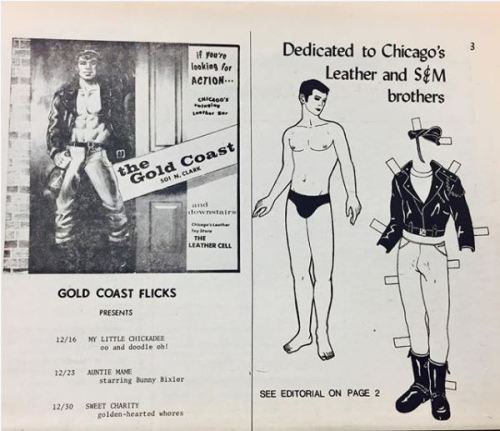
Thanks to Owen Keehnen for sharing this bit of leather history the other day. Here’s an ad that appeared in the Chicago Gay Defender (1973) for the Gold Coast leather bar. Who wouldn’t want their own leatherman paper doll?
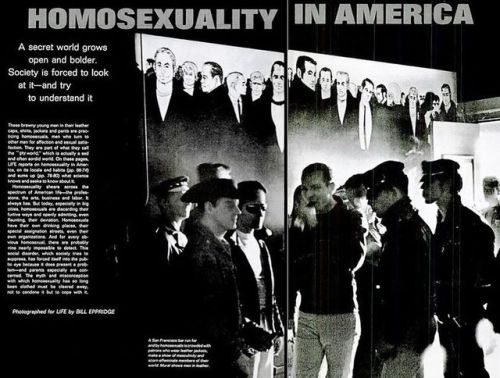
“A SECRET WORLD GROWS OPEN AND BOLDER. SOCIETY IS FORCED TO LOOK AT IT—AND TRY TO UNDERSTAND IT…HOMOSEXUALITY IN AMERICA,” by Paul Welch, Life, June 26, 1964.
.
On June 26, 1964, fifty-three years ago today, Life offered a fourteen-page “report on homosexuality” that more accurately can be described as a report on America’s ignorance of, and distaste for, homosexuals. The subjects, according to the author, “are part of what they call the ‘gay world,’ which is actually a sad and often sordid world…This social disorder, which society tries to suppress…does present a problem–and parents are especially concerned.”
.
While the article was groundbreaking in that it featured now-familiar names (e.g., pioneer José Sarria), places (e.g., legendary leather bar The Toolbox (pictured)), and organizations (e.g., Mattachine Society and ONE), it also perpetuated stereotypes (listing, for example, “those professions favored by homosexuals” as “interior decorating, fashion design, hairstyling, dance and theater”), emphasized self-loathing among gay men (quoting a bar owner as saying, “This is a place for men, a place without all those screaming faggots, fuzzy sweaters, and sneakers”), and explored the tension between the equally harmful views of law enforcement (describing the “unrelenting crackdown on homosexuals” in Los Angeles) and certain religious organizations, which “[did] not condone homosexuality but [did] regard it as a psychological problem.”
.
Interestingly, the article noted a recent legal challenge to the Civil Service Commission’s regulations prohibiting homosexuals from working in the federal government; while not named in the article, Bruce C. Scott, a member of the Mattachine Society of Washington, D.C., was behind that challenge. On June 26, 1965, a year after the LIFE article, Mattachine Washington and other groups made history by picketing the Civil Service Commission in support of Scott’s case. #lgbthistory #HavePrideInHistory #Resist (at San Francisco, California)
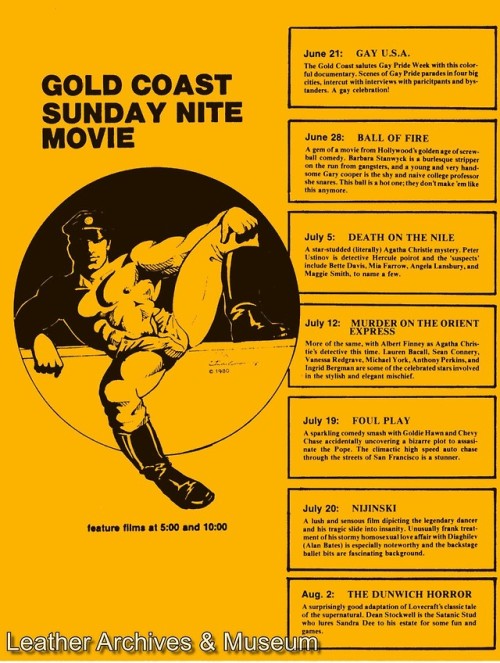
Artist Dom Orejudos (Etienne) was a huge movie buff, often spending his days going to all the big theaters in downtown Chicago to see film after film. Chuck Renslow, Orejudos’ partner, has been quoted that “Dom could name almost every movie ever made and who starred in it and all that sort of thing.” Orejudos decided that the Gold Coast leather bar (which used to be located at 501 N. Clark Street) should host films, so it became a long-standing tradition for the bar to host a Sunday Nite Movie. Orejudos was in charge of renting the films from the big movie rental vaults down on South Wabash Avenue. “That was the area where all the movie companies, MGM and Warner Brothers and so on, had their vaults,” said Renslow. It was a huge success. The Sunday 5 and 10 p.m. showings were wall-to-wall men.
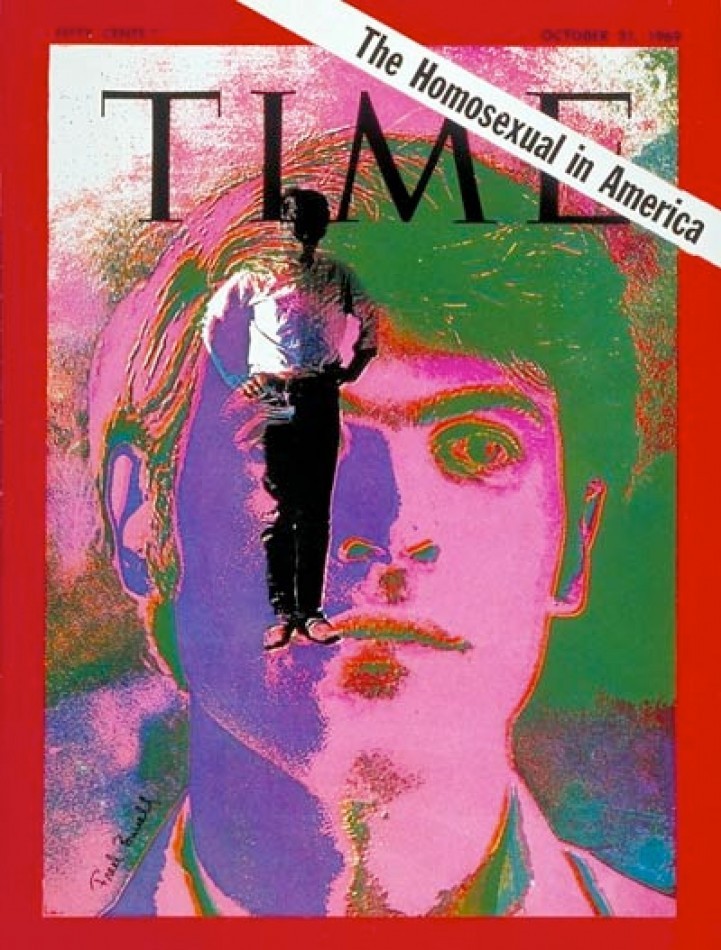
The Homosexual in America
The first cover story on gay rights in a national magazine
On Oct. 31, 1969, Time devoted it cover story to “The Homosexual in America.” According to Time “inverts” are divided into six “homosexual types.” Time reported: “Though they still seem fairly bizarre to most Americans, homosexuals have never been so visible, vocal or closely scrutinized by research. They throw public parties, frequent exclusively ‘gay’ bars (70 in San Francisco alone), and figure sympathetically as the subjects of books, plays and films. Encouraged by the national climate of openness about sex of all kinds and the spirit of protest, male and female inverts have been organizing to claim civil rights for themselves as an aggrieved minority. Their new militancy makes other citizens edgy, and it can be shrill. … Most straight Americans still regard the invert with a mixture of revulsion and apprehension, to which some authorities have given the special diagnostic name of homosexual panic. A Louis Harris poll released last week reported that 63% of the nation consider homosexuals ‘harmful to American life,’ and even the most tolerant parents nervously watch their children for real or imagined signs of homosexuality.”
Time identified, broadly, six types of homosexuals:
“The Blatant Homosexual”:
This is the eunuch-like caricature of” femininity that most people associate with homosexuality. In the 1960s he may be the catty hairdresser or the lisping, limp-wristed interior decorator. His lesbian counterpart is the “butch,” the girl who is aggressively masculine to the point of trying to look like a man. Blatants also include “leather boys,” who advertise their sadomasochism by wearing leather jackets and chains, and certain transvestites, or “Tvs.”
“The Secret Lifer”:
The other 90% of the nation’s committed inverts are hidden from all but their friends, lovers, and occasionally, psychiatrists. Their wrists are rigid, their “s’s” well formed; they prefer subdued clothes and close-cropped hair, and these days may dress more conservatively than flamboyant straights. Many wear wedding rings and have wives, children and employers who never know. … To lead their double lives these full or part-time homosexuals must “pass” as straight, and most are extremely skilled at camouflage. They can cynically tell — or at least smile at — jokes about “queers”; they fake enjoyment when their boss throws a stag party with nude movies.




Spreads from Pink Mince looking pretty fancy in “Letraset: The DIY Typography Revolution” from @uniteditions
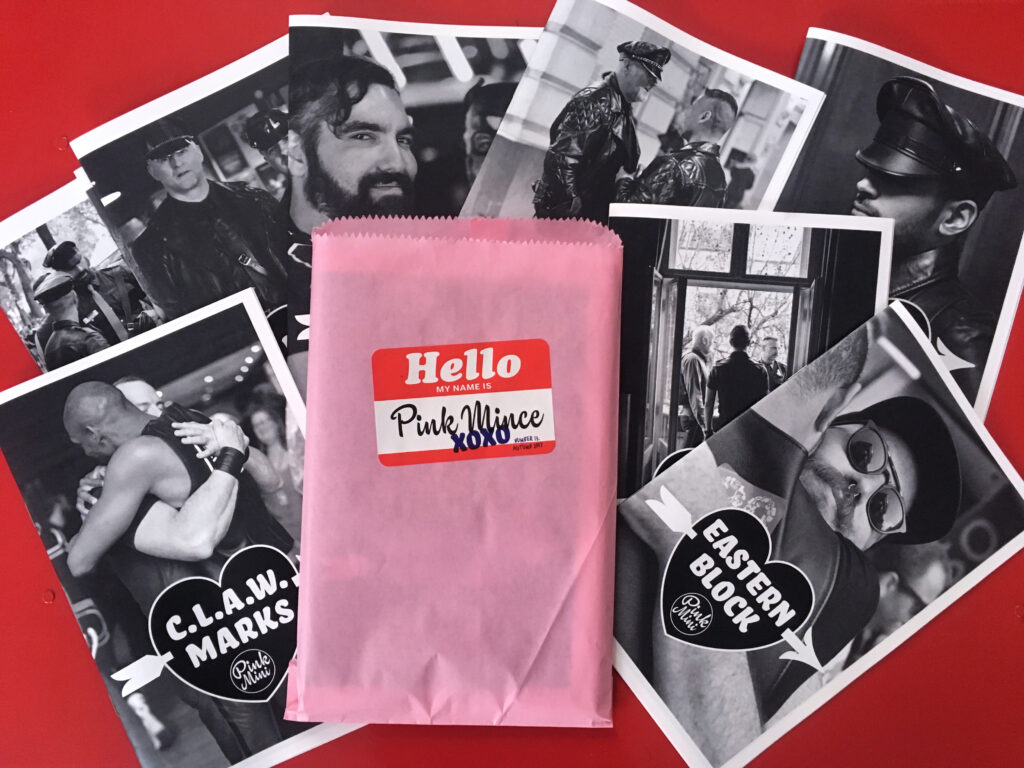
Pink Mince #13 — XOXO — grew into a year-long photo project, but it started as a just a day back in September 2016 when I visited Berlin for Folsom Europe and wanted to have my camera on hand to take some snaps and keep me from feeling too fidgety. I wasn’t expecting to see so many people I’d know over the years, or for one day’s photography to turn into a year of making new friends and documenting the leather subculture.
Order Pink Mince #13 and other issues at http://pinkmince.com

Pansy Craze: the wild 1930s drag parties that kickstarted gay nightlife
The 1920s also saw an increase in the number of bohemian enclaves in rundown areas, such as New York’s Greenwich Village. Painters, poets and performers were lured by the cheap rents and by an increasingly wild and lawless lifestyle. Prohibition had given birth to a black market for booze and a bustling underground scene, where bright young things slumming it in mob-run nightspots developed a taste for camp, cutting repartee.
LGBT people were flocking to cities as much for the nightlife as for the ability to connect with others. Soon, Variety was reporting that Broadway “will have nite places with ‘pansies’ as the main draw. Paris and Berlin have similar night resorts, with the queers attracting the lays.” In Berlin, you could hear singers performing Das Lila Lied (The Lavender Song), one of the earliest songs to celebrate homosexuality. “This song became the gay anthem of the time and still has status today,” says singer Ute Lemper. “The lyrics are witty and ballsy, quite unbelievable.” You can hear its influence in the work of Rufus Wainwright, Marc Almond and others.
Every European capital, and several major US cities, had similar scenes: London had Douglas Byng and Noël Coward, who once admitted: “I should love to perform There Are Fairies in the Bottom of My Garden, but I don’t dare. It might come out There Are Fairies in the Garden of My Bottom.”
Performers, including the acid-tongued Malin, quickly eclipsed the drag acts that had been a stage staple for decades. Malin began his own career in drag, as Imogene Wilson, but it was as the tuxedoed MC of Club Abbey that he “gave Broadway its first glimpse of pansy nightlife”, as Mark Hellinger of the Syracuse Journal put it. At Club Abbey, Malin ditched the dresses and reinvented himself as a high-camp, waspish, obviously gay man – and it was this that singled him out. For possibly the first time ever, an entertainer’s entire act revolved around an explicit queerness. “What was novel is that he did not bring a drag act to the club, but instead performed in elegant men’s clothing, and brought with him the camp wit of the gay subculture,” explains LGBT historian JD Doyle. “If he was heckled by men at the club he knew how to cut them to shreds, to the delight of the crowd.” At 200lbs and over six feet tall, few would argue with him anyway.

Pink Mince #13 — XOXO — is a set of 10 mini-zines, a 164-page collection of portraits taken at leather events over a 12-month period. Come check it out at the New York Queer Zine Fair or order a set from pinkmince.com
After a trial run of this subject at the Kerning conference this summer, I gave another presentation about the typography of vintage gay magazines, at ATypI in Montreal a couple of weeks ago.
Missing from the clip is my opening joke, which went over well: “The last talk of the day before cocktails seems like a good time to talk about gay porn.”